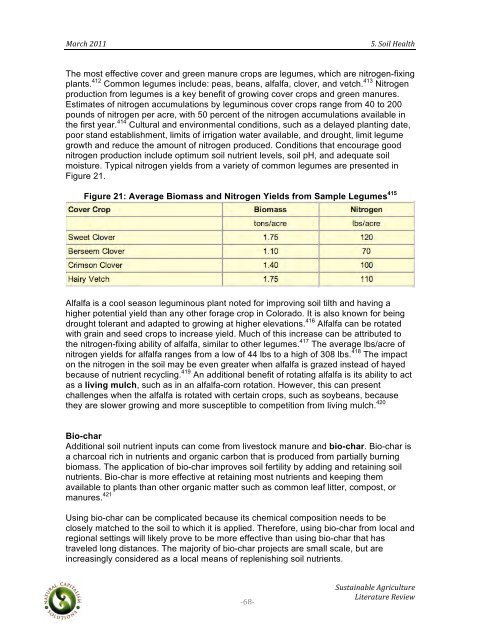Sustainable Agriculture Literature Review - Boulder County
Sustainable Agriculture Literature Review - Boulder County
Sustainable Agriculture Literature Review - Boulder County
Create successful ePaper yourself
Turn your PDF publications into a flip-book with our unique Google optimized e-Paper software.
! !!<br />
"#$%&!'())!! !!!!!!!!!!!!!!!!!!!!!!!!!!!!!!!!!!!!!!!!!!!!!!!!!!!!!!!!!!!!!!!!!!!!!!!!!*+!,-./!01#/2&!<br />
The most effective cover and green manure crops are legumes, which are nitrogen-fixing<br />
plants. 412 Common legumes include: peas, beans, alfalfa, clover, and vetch. 413 Nitrogen<br />
production from legumes is a key benefit of growing cover crops and green manures.<br />
Estimates of nitrogen accumulations by leguminous cover crops range from 40 to 200<br />
pounds of nitrogen per acre, with 50 percent of the nitrogen accumulations available in<br />
the first year. 414 Cultural and environmental conditions, such as a delayed planting date,<br />
poor stand establishment, limits of irrigation water available, and drought, limit legume<br />
growth and reduce the amount of nitrogen produced. Conditions that encourage good<br />
nitrogen production include optimum soil nutrient levels, soil pH, and adequate soil<br />
moisture. Typical nitrogen yields from a variety of common legumes are presented in<br />
Figure 21.<br />
!<br />
Figure 21: Average Biomass and Nitrogen Yields from Sample Legumes 415<br />
Alfalfa is a cool season leguminous plant noted for improving soil tilth and having a<br />
higher potential yield than any other forage crop in Colorado. It is also known for being<br />
drought tolerant and adapted to growing at higher elevations. 416 Alfalfa can be rotated<br />
with grain and seed crops to increase yield. Much of this increase can be attributed to<br />
the nitrogen-fixing ability of alfalfa, similar to other legumes. 417 The average lbs/acre of<br />
nitrogen yields for alfalfa ranges from a low of 44 lbs to a high of 308 lbs. 418 The impact<br />
on the nitrogen in the soil may be even greater when alfalfa is grazed instead of hayed<br />
because of nutrient recycling. 419 An additional benefit of rotating alfalfa is its ability to act<br />
as a living mulch, such as in an alfalfa-corn rotation. However, this can present<br />
challenges when the alfalfa is rotated with certain crops, such as soybeans, because<br />
they are slower growing and more susceptible to competition from living mulch. 420<br />
Bio-char<br />
Additional soil nutrient inputs can come from livestock manure and bio-char. Bio-char is<br />
a charcoal rich in nutrients and organic carbon that is produced from partially burning<br />
biomass. The application of bio-char improves soil fertility by adding and retaining soil<br />
nutrients. Bio-char is more effective at retaining most nutrients and keeping them<br />
available to plants than other organic matter such as common leaf litter, compost, or<br />
manures. 421<br />
Using bio-char can be complicated because its chemical composition needs to be<br />
closely matched to the soil to which it is applied. Therefore, using bio-char from local and<br />
regional settings will likely prove to be more effective than using bio-char that has<br />
traveled long distances. The majority of bio-char projects are small scale, but are<br />
increasingly considered as a local means of replenishing soil nutrients.<br />
"%,"<br />
!,342#.5#6/1!78$.%3/23$1!<br />
9.21$#23$1!:1;.1
















